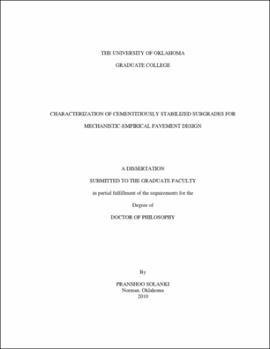| dc.contributor.advisor | Zaman, Musharraf M | |
| dc.creator | Solanki, Pranshoo | |
| dc.date.accessioned | 2019-04-27T21:25:49Z | |
| dc.date.available | 2019-04-27T21:25:49Z | |
| dc.date.issued | 2010 | |
| dc.identifier | 99186674202042 | |
| dc.identifier.uri | https://hdl.handle.net/11244/318660 | |
| dc.description.abstract | Pavements are vulnerable to subgrade layer performance because it acts as a foundation. Due to significant increase in truck traffic, pavement engineers are challenged to build more strong and long-lasting pavements. To increase the load-bearing capacity of pavements, subgrade layer is often stabilized with cementitious additives. Thus, an overall characterization of cementitiously stabilized subgrade layer is important for enhanced short- and long-term pavement performance. | |
| dc.description.abstract | In this study, the effect of type and amount of additive on the short- and long-term performance of stabilized subgrade in terms of material properties recommended by the new Mechanistic Empirical Pavement Design Guide (MEPDG) is examined. A total of four soils commonly encountered as subgrades in Oklahoma and three locally available cementitious additives namely, hydrated lime, class C fly ash (CFA) and cement kiln dust (CKD) are utilized. Cylindrical specimens are compacted, cured for 28 days, and then subjected to different stress sequences to determine the resilient modulus (Mr) followed by modulus of elasticity (ME) and unconfined compressive strength (UCS) test. Results show that the changes in the Mr, ME and UCS values of stabilized specimens depend on the soil type and properties of additives. The long-term performance of stabilized soil specimens is investigated by conducting freeze-thaw (F-T) cycling, vacuum saturation and tube suction tests on 7-day cured stabilized soil specimens. Also, specimens are capillary-soaked for 60 days and tested for Mr, as an additional indicator of long-term performance. This study is motivated by the fact that during the service life of pavement stabilized layers are subjected to F-T cycles and moisture variations. It is found that that UCS value of all the stabilized specimens decreased with increase in the number of F-T cycles. A strong correlation is observed between UCS values retained after vacuum saturation and F-T cycles indicating that vacuum saturation could be used as a time-efficient and inexpensive method for evaluating durability of stabilized soils. | |
| dc.description.abstract | For Level 2 design of pavements, a total of four stress-based statistical models and two feed-forward-type artificial neural network (ANN) models, are evaluated for predicting Mr of 28-day cured stabilized specimens. Specifically, one semi-log stress-based, three log-log stress-based, one Multi-Layer Perceptrons Network (MLPN), and one Radial Basis Function Network (RBFN) are developed. Overall, semi-log stress-based and MLPN neural network are found to show best acceptable performance for the present evaluation and validation datasets. Further, correlations are presented for stress-based models to correlate Mr with compacted specimen characteristics and soil/additive properties. | |
| dc.description.abstract | In addition, the effect of type of additive on indirect tensile and fatigue characteristics of selected stabilized soil specimens is evaluated. This study is based on the fact that stabilized layer is subjected to tensile stresses under wheel loading. Thus, the resilient modulus in tension (Mrt), fatigue life and strength in tension (σt) or flexure (represented by modulus of rupture, MOR) becomes another important design parameter within the mechanistic framework. Cylindrical specimens are subjected to different stress sequences in indirect tension to study the Mrt, whereas beam specimens are subjected to repeated cycles of reloading-unloading in a four-point beam fatigue apparatus for evaluating fatigue life and flexural stiffness. It is found that all three cementitious additives improved the Mrt, σt and MOR values; however, degree of improvement varied with the type of additive and soil. The magnitude of resilient modulus in tension is found lower than it is in compression. Findings from this study shed light on the differences in properties of cementitiously stabilized soil in indirect tension, flexure and compression. The fatigue life values and model of stabilized specimens is expected to provide a better understanding of performance of cementitiously stabilized layers in mechanistic sense. | |
| dc.description.abstract | Further, this study encompasses the differences in the design of semi-rigid pavements developed using AASHTO 1993 and AASHTO 2002 MEPDG methodologies. The design curves for fatigue performance prediction of stabilized layers are developed for different cementitiously stabilized pavement sections. It is found that the design thickness is influenced by the type of soil, additive, selection of material property and design method. Cost comparisons of sections stabilized with different percentage and type of additives is also made. Knowledge gained from the parametric analysis of different sections using AASHTO 1993 and MEPDG is expected to be useful to pavement designers and others in implementation of the new MEPDG for future pavement design. | |
| dc.format.extent | 340 pages | |
| dc.format.medium | application.pdf | |
| dc.language | en_US | |
| dc.relation.requires | Adobe Acrobat Reader | |
| dc.subject | Pavements--Design and construction | |
| dc.subject | Pavements--Subgrades | |
| dc.subject | Soil stabilization | |
| dc.subject | Lime | |
| dc.subject | Fly ash | |
| dc.subject | Cement | |
| dc.title | CHARACTERIZATION OF CEMENTITIOUSLY STABILIZED SUBGRADES FOR MECHANISTIC-EMPIRICAL PAVEMENT DESIGN | |
| dc.type | text | |
| dc.type | document | |
| dc.thesis.degree | Ph.D. | |
| ou.group | College of Engineering::School of Civil Engineering and Environmental Science | |
